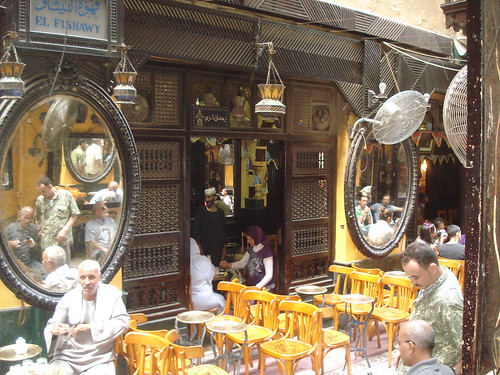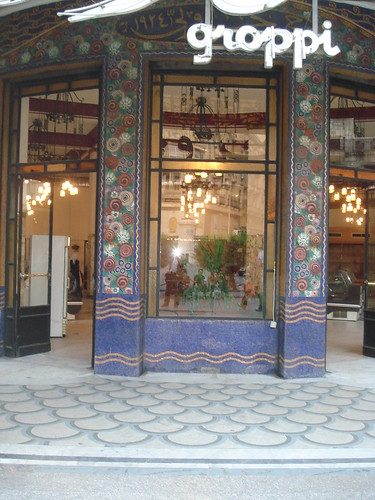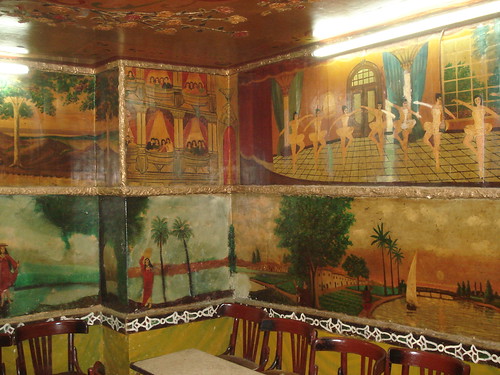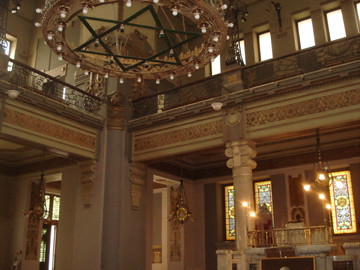I have written here and here about my visit to Eritrea in 2010 At the time, the quickest way to get to Eritrea was to fly with Egyptian Airlines via Cairo. I decided that this was too good an opportunity to miss and spent a few days in Cairo on the way home.
Yes, I visited the pyramids, the Egyptian Museum, the Citadel, mosques and other "normal" tourist attractions, but I went to Cairo to search for a different part of this enormous city's history. I had read several books about Cairo in the first half of the 20th century when it was an extremely cosmopolitan city, peopled by Greeks, Italians, Armenians and Jews as well as Arabs and a whole range of other peoples. This was the city of Naguib Mahfouz, the city with a thriving cafe society, with exquisite art deco and art nouveau buildings, and the city of great musicians and singers such as Layla Murad, Oum Kalthoum and Abdel Wahab.
As I expected, much of this Cairo had long since disappeared. The population is much less diverse due to many "foreigners" being driven out during the 1950's and 60's and a growing intolerance of minority groups. The grand buildings from this period are for the most part neglected and the cafes were a shadow of the delights described in the novels of Mahfouz. But despite this, there were glimpses of times gone by and now more than ever, I am glad that I took what might have been the last opportunity for some time, to enjoy them.
One of my lasting memories of the city will be the deafening noise and the incredible mass of people who flood the city streets from early in the morning until very late at night. It was not unusual to see families with small children promenading along the main shopping streets of Cairo as late as midnight and beyond. The streets in the downtown area where I stayed were full of shops selling clothes, fabrics, food, shoes, books, electronic equipment, assorted junk and just about anything you might ever want or need. As well as the shops, there were hundreds of street traders setting up stall on the kerb side again selling all manner of things, including impromptu book stalls with huge collections of books and magazines in Arabic, CDs, DVDs, watches and a variety of gadgets.
So, what did I find in my search for an earlier time? Well I found my hotel to begin with. The Talisman Hotel de Charme, which sits on the upper floors of a belle époque building at 39 Sharia Halat Tarb. Wonderfully decorated in North African style, it was friendly, had a great little library and computer lounge, offered advice on how best to reach different places and which taxis to use or avoid, was spotlessly clean and best of all, was managed (owned?) by a fearsome French speaking woman of a certain age, dressed in black sheath dresses, hair in a chignon and eyebrows plucked within a quarter of an inch of their lives.
Each morning at breakfast there was a sweet smile and "Bonjour" from madame, but the darker side was also visible. The breakfast room staff were young, uniformed Egyptian men. If she thought they were talking to each other too much or was displeased with the positioning of a single item on the tables, one of the thin eyebrows would arch and a particular look would be given to the nearest employee, who knowing she meant business would instantly correct the fault. They really don't make them like that anymore. Sadly.
The hotel was accessed either by a lung squeezing walk up a very impressive staircase with art nouveau metalwork or in a fantastic lift with the old style metal draw-across gate. The lift carried an interesting notice. "Dear guests, please note, the hotel does not employee a lift attendant. Anyone claiming to be the attendant is not the attendant and should not be given money". Very entrepreneurial. I like it.
The downtown area was the focus of my evening explorations and of the third day I spent in Cairo. For the first two days I took a driver and a guide to help me navigate the city, to get as quickly as possible from one place to another in order to maximise the time and to help me survive the robust harassment at the major tourist sites. It felt like a good plan, but I hadn't bargained for being harassed by the guide who also snook in a few visits to see "a demonstration" of carpet making, papyrus manufacturing and a range of other attempts at getting me to part with my hard earned money for stuff I didn't want. He eventually got the message when I told him I didn't want to see demonstrations of anything and if I wanted to buy any presents, it wouldn't be at any of these places. Best to be clear I always find.
But back to the down town exploration. I had read a lot about this area. Once heavily populated by Europeans, it is still home to some very fine, albeit neglected buildings. Their names evoke days long gone by, for example the former Cicurel and Ades department stores on 26th July Street and Sharia Emad El-din respectively. The Ades building (pictured below) is particularly striking with its stylish corner tower and art deco features. Both were formerly owned by Jewish families, originating from Izmir (Cicurel family) and Aleppo (Ades family). Both were confiscated by the Egyptian government following the 1957 Suez crisis.
 |
| Former Ades department store |
The Trieste Building in Sharia Qasr el-Nil is an art nouveau influenced building designed by Antonio Lasciac, for the Assicurazioni Generali Trieste insurance company. Lasciac is a wonderful example of the former cosmopolitan nature of this city, an Italian-Egyptian architect, born in Trieste, he was responsible for several buildings in Cairo and this one has been described as being neo-Islamic in style. There are beautiful ceramic tiles on the front of the building bearing its name.
Not too far away, you can find the Yacoubian Building at 34 Talaat Harb, next door to the art deco Miami Theatre. It was built by Armenian businessman Hagop Yacoubian in 1934. The building, whose inhabitants were the subject of Alaa Al-Aswany's book of the same name, was once the home to wealthy business owners, foreigners and government ministers. This all changed with the 1952 revolution that deposed King Farouk and eventually put Gamal Abdel Nasser into power. Many of the former residents fled (or had to flee) the country and the building became home to military officers and their families. The rooftop spaces which feature significantly in the book were initially intended as storage areas but over several years have developed into living places - in effect, a roof top shanty town. The excellent book is a microcosm of Egyptian society, tackling subjects as diverse as Islamic fundamentalism, corruption and homosexuality, illustrating the hopes and fears of the building's residents. The 2006 award winning film of the book, directed by Marawan Hamed is also well worth a viewing.
Nobel Prize winning author, Naguib Mahfouz, one of my all time favourite writers explores these themes across his many books. His most famous work - the Cairo trilogy (Sugar Street, Palace of Desire and Palace Walk) follows the changing fortunes of the Al Jawad family from the beginning of the 20th century to the 1950's. The trilogy begins with the unquestioned authority of the patriarch Ahmad, the stirrings of rebellion amongst his sons as the Egyptians protest against British influence, the development of new and warring political groupings and pressure for social change. As the story develops we see Ahmed's power wane, his wife's authority increase and his sons take differing routes including taking on some of their apparently pious father's penchants for drinking, visiting prostitutes and indulging in a range of vices. Mahfouz' descriptions of the descent into old age and infirmity is extremely touching as Ahmad comes to realise that his power has gone.
Like many of his books, the Cairo Trilogy shows the less pretty side of Cairene life, but perhaps his most notorious work was Midaq Alley, named after and based on the inhabitants of, a back street in the city. The list of characters includes an hashish selling cafe owner who has a predilection for young men, a self-proclaimed dentist who sells false teeth sourced from dead bodies, a matchmaker, a baker who beats her husband with her slippers, a politician, a pimp and a beautiful young woman dreaming of a better life. Its a great story, sad and funny, and a good introduction to the type of characters Mahfouz draws so well.
Mahfouz was an habitué of many of Cairo's cafes. Coffee was introduced to Egypt from Yemen in the middle ages and has been popular ever since. There are literally hundreds of "ahwas" in Cairo - holes in the wall coffee houses where men sit and talk, drink, and play board games. Some ahwas are a little more sophisticated and Mahfouz' favourite was Al-Fishawis in Khan el-Khalili (pictured below). Al-Fishawis has high ceilings, tall mirrors, battered old furniture, a little corner dedicated to the writer and his friends and still serves a great cup of Arabic coffee with a small plate of baklava and other sweets. I spent a short time there and was happy to note that amongst the tourists, there were still many Cairenes (men and women). I was fascinated by a woman in a bright purple outfit with richly hennaed hair peeping from under her hijab.
 |
| El-Fishawy cafe |
The European communities left their mark on cafe society in Cairo, with the formerly Swiss owned Groppi's at Midaan Talat Harb once being the preferred cafe of the middle classes, popular with Jews and Armenians in particular. In her beautifully written book, "The Man in the white sharkskin suit", Egyptian born Lucette Lagnado writes about being taken there by her father as one of the most enduring memories of her childhood.
The book is an excellent record of a society that is no more - that of Egyptian Jewry, at its peak consisting of up to 80,000 people, now numbering less than 100 having been driven out in the 1950's and 1960's due to increasingly virulent and often violent anti-semitism, economic discrimination and wholesale confiscation of assets. As in many Arab countries, as Jews left they were forbidden to take items of value and many were robbed by customs officers and police as they boarded ships or planes. Readers wanting to know more about this period and the fate of other Jewish communities in Arab countries should visit the excellent website Point of no return.
Today's Groppi's (pictured below) is disappointing. The exterior of the cafe is as striking as in any photograph of earlier times with the beautiful, brightly coloured mosaic walls looking out over the Midaan, but the interior has been hacked to pieces with the most appalling bad taste plastic furnishings in the inner room and horror upon horrors, a massive TV screen. Lagnado's father would not have approved. And sadly the patisserie is nothing special either.
 |
| Groppi's cafe |
If Groppi's was disappointing, I was grateful to my guide for showing me a cafe that was an absolute delight. The El Shems cafe (pictured below) near Midan Orabi in the passage by 4 Sharia Tawfiqa is beyond kitsch, with every patch of wall decorated with brightly coloured images of dancers, animals and scenes from ancient Egypt, whilst the customers enjoy coffee, mint tea, sweets and the obligatory water pipe or sheesha. I even ventured back to this cafe on my own in the evening to drink coffee and read my book, as well as to observe the backgammon games and the comings and goings of the customers. Another treat is the Oum Kalthoum cafe on Sharia Al-Azbakiyah - a total tribute to the great vocalist, bedecked with her pictures and playing a non-stop soundtrack of her thousands of recordings. Good coffee too.
 |
| El Shems cafe |
Regular readers will know that as well as my special interest in coffee and cakes, I have a bit of a thing for book shops. Cairo did not disappoint and I found two particularly good shops - Lehnert and Landrock, founded by the German photographers of the same name. The main branch is in Sharia Sherif, still in Downtown and as well as books they sell great postcards and prints of old photos (including some of their own), maps of Cairo and Egypt and guide books in a range of languages. I was tempted to part with a tidy sum for a number of postcards from the 1950's, including some stamped with "United Arab Republic" - the name of the short lived union between Egypt and Syria (1958-61). There is another branch near the Sphinx. Also excellent, and with great staff was Shorouk at Midaan Talat Harb which has a good collection of Egyptian fiction translated into English. They are open until 11pm every day.
I managed to visit two synagogues whilst in Cairo. The Ben Ezra synagogue in the Coptic Cairo compound is easy to visit. The site of the famous Cairo Genizah, the synagogue dates from the 12th century, was restored in the 1980's and acts as a museum now, serving no religious function. The building was busy with tourists - although photography is strictly forbidden - and was in excellent condition but has a terrible sadness about it in that the community that built it, used it and had centuries of continuous history is long gone. This sadness is similar to that of many synagogues in central and eastern Europe that are also without communities following the Holocaust. Fortunately this was not enacted on the Jews of Egypt but they too suffered appalling anti-semitism that eventually forced them out of the country.
I also visited the stunningly beautiful Shar Hashamaim synagogue on Adley Street. This was somewhat more difficult to visit. The building had been the object of an attempted terrorist attack a few months before my visit and had a heavy armed police and military presence, with strict questioning on the purpose of my visit and lengthy examination of my passport before I was admitted. The interior is beautifully preserved with many art deco style features (although it dates from an earlier period - 1905). A woman was on duty inside the synagogue to explain in very limited English the different features of the building. She was wearing a cross around her neck. She allowed me to take pictures but told me to be quick, to take only a few and to not tell anyone I had done so. Photographs are strictly forbidden, including of the exterior which is a terrible shame as this is one of the most interesting buildings in the Downtown area, featuring palm tree symbols and Cecil B. de Mille style architecture. Services are very occasionally held here but rarely with a minyan and most of the congregants tend to be foreign visitors or embassy staff.
For those interested in knowing more about the history of Egyptian Jewry, Andre Aciman's book "Out of Egypt" is an excellent account of their twentieth century experience, whilst the flickr group Les Juifs d'Egypte is a wonderful photographic record of the community.
So, did I find what I was looking for? Was it worth the stopover on my way back from Eritrea? Definitely yes. The city still offers a glimpse into the Cairo I imagined, with the Yacoubian and Trieste buildings enduring, the Ades store closed but still a magnificent site, the sadness and the beauty of the empty synagogue on Adley Street, the delights of Al-Fishawis, the continuing interest in literature with book shops full of browsers and book stalls in the street managing to make a living and my little find - the El Shems cafe. Will I go back? There are still things I would like to see again, to understand better, and things I missed in the short time I was there. Time will tell.

No comments:
Post a Comment